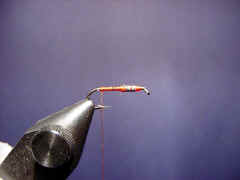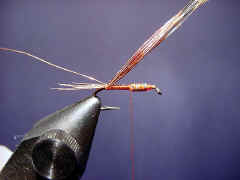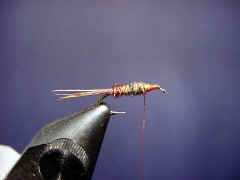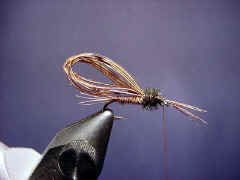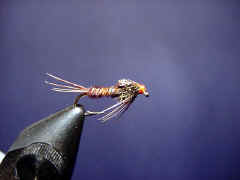|
Fly of the Month Bob Ireton brings together his experience in fly fishing, aquatic entomology, and knowledge of fly tying techniques and materials, to design and tie durable and effective flies. |

|
![]()
Volume 3, Issue 12 December
2002
![]()
PHEASANT TAIL NYMPH
Fly and Text by Bob Ireton
Photography by Bob Kimsey and Bob Ireton
The pheasant tail nymph was first designed by British river keeper Frank Sawyer, who twisted the wire and pheasant tail fibers around one another, and wrapped them forward together, forming the abdomen and thorax. This fly suggests many of the skinny mayfly nymphs that live in habitats from fast riffles to the slower pools of rocky streams, in clear, weedy spring creeks and tailwaters, and in ponds and lakes.
Tying a pheasant tail nymph seems straightforward enough. However, as I did research on this fly, I found many different variations of tying it. Some were simple and basic, and others were more involved. So I examined some of the specimens of mayfly nymphs in my collection, and saw that pheasant tail nymphs look most like a swimmer mayfly nymph, and similar to a crawler mayfly nymph. I also talked to my friend Dan, who lives in Eastern Tennessee and uses this pattern to fish the tailwaters there, for his thoughts about this pattern. I considered all this information, and came up with a pattern using what I felt was the best of these resources.
This is one of the most important patterns for trout, and definitely one that should be in every fly box.
MATERIALS:
Hook
Size 10-24 TMC 5262, Dai-Riki 730, Daiichi 1710, Orvis 1524, or Mustad 9671
Thread 6/0 or 8/0 Rusty Brown Tail Ringneck pheasant tail fiber tips Weight Lead wire same diameter or smaller than hook shank Rib Copper wire Body Ringneck pheasant tail fibers Wingcase Ringneck pheasant tail fibers Thorax Bronze peacock herl Legs Ringneck pheasant tail fiber tips
TYING STEPS
![]()
Copyright © 1998 - thisyear The Buckeye United Fly Fishers, Inc. Cincinnati, OH 45242
The Buckeye United Fly Fishers, Inc is a non-profit corporation organized under section 501(c)(3) of the Internal Revenue Code, incorporated in the State of Ohio for the preservation, conservation and wise use of our fishing waters and game fish; and to assist in the protection and improvement of our natural resources
